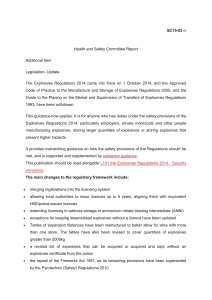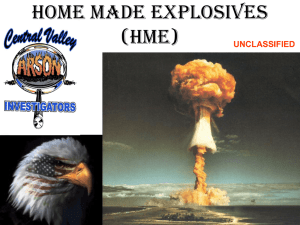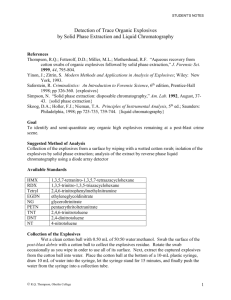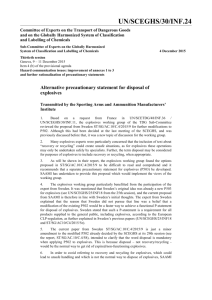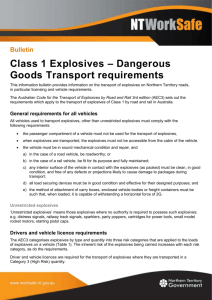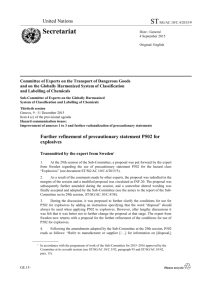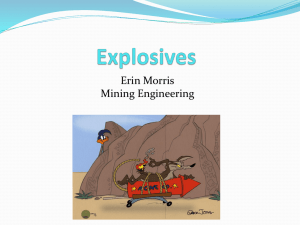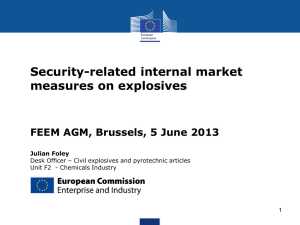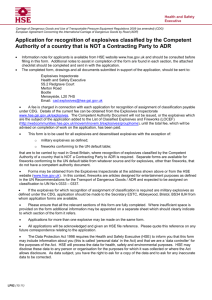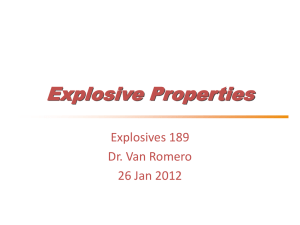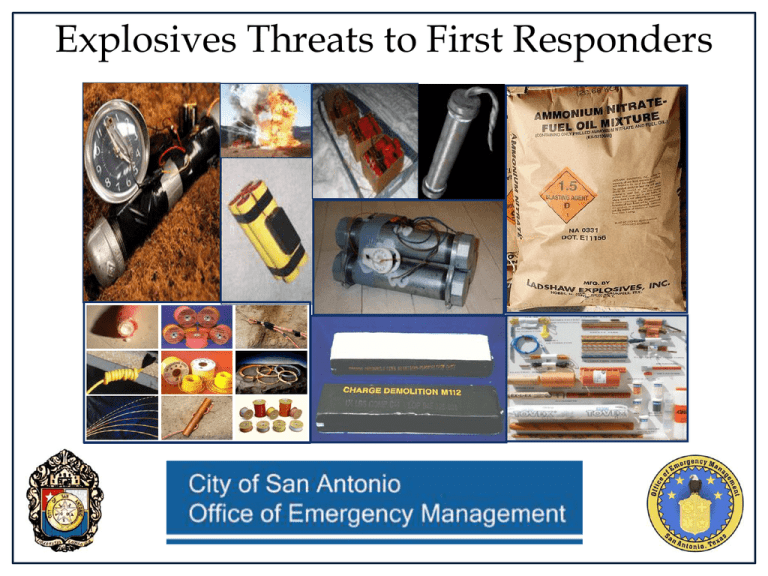
Explosives Threats to First Responders
Introduction
This is a workshop presenting recognition of Improvised
Explosive Devices (IEDs), homemade explosives, and
explosives precursors. The workshop will include
information on the four components of an IED, types of
stimulus, three types of explosives response incidents,
evacuation decisions, shelter-in-place, and response safety
issues.
Workshop Developer
Mark Chadwick, CEM
Training Officer
mark.chadwick@sanantonio.gov
(210) 206-8688
Objectives
1. Recognition of common IED's, homemade
explosives, and precursors.
2. Recognition of the basic components of an
IED.
3. Identification of the three main types of
explosives response incidents.
4. Emphasis on first responder safety
concerns for explosives response.
IED Components
•
•
•
•
Power Supply
Initiator
Explosive
Switch
• Container
Power Supply
Initiators
Explosives
Switches
Containers
Imagination is the
ONLY limit!
Explosives Stimuli
•
•
•
•
•
Friction
Impact
Shock
Heat
ED – Electrostatic Discharge
• Radio Frequencies
Common Types of IEDs
Pipe Bomb: ½ lb of Black Powder
Pipe Bomb in Slow Motion
Gas Bomb in Plastic Bottle
50 lb Explosion
ALF Incendiary Device
Homemade Explosives
What makes Homemade
Explosives a weapon of
choice?
Keep in mind that it was a
Homemade Explosive that was
used in Oklahoma City.
They are made from ordinary
household products
The products can be purchased
or possessed legally
They are cheaper to make
You don’t need a lab to make
them
They are simple to make
They can be just as effective as
Commercial or Military
explosives
Sources
The Internet, books,
bookstores, libraries, and
people with an interest in
explosives are all sources
that can be used to learn
how to make Homemade
Explosives.
Explosives Precursors
Poor Man’s C-4
Potassium Chlorate + Vaseline
Types of HMEs: Ammonium Nitrate-Based
Ammonium nitrate-based explosives, consisting of ammonium nitrate and another
precursor that serves as a fuel, are the most widely used types of binary explosives.
Popular fuels to mix with AN include:
Fuel oil (ANFO)
Sugar (ANS)
Aluminum powder (ANAL)
Nitromethane (ANNM)
Ammonium Nitrate
Ammonium Nitrate Sugar (ANS)
Ammonium Nitrate / Nitromethane
Aluminum Powder
Ammonium Nitrate + Aluminum (AN/AL)
Ammonium Nitrate + Fuel Oil (AN/FO)
Types
of HMEs:
Hydrogen
Peroxide-Based
Extremely sensitive
to heat,
shock, and
friction, hydrogen
peroxide-based explosives,
such as HMTD and TATP, are some of the most commonly used HME in IEDs.
Food Additives
for Citric Acid
Camp Stove Fuel
Tablets for
Hexamine
Hexamethylene
Triperoxide
Diamine (HMTD)
Drain Cleaners for
Sulfuric Acid
Hair Bleach for
Hydrogen Peroxide
Nail Polish
Remover for
Acetone
Triacetone Triperoxide
(TATP)
The Millennium bomber, Ahmed Ressam, planned to use HMTD as part of an IED
attack on the Los Angeles International Airport on New Years Eve 1999, while
Richard Reid in 2001 attempted to use TATP as a booster in his shoe bomb.
TATP
TATP Explosion
Additional
Dangers
of HME
fordrugs
Lawduring
Enforcement
Law Enforcement
Officers
may mistake
HME for
initial investigation.
+
=
Portable drug test kits sold under the name NIK are designed to test for cocaine, PCP,
LSD and brown heroin. If mixed with TATP or HMTD, the reaction may be violent
resulting in injury to the officer.
Urea Nitrate
Mercury Fulminate
3 Types of Response to Explosives
Incidents
• Pre-Detonation
Response to a threat by phone, email, letter, note, or inperson where a detonation has not yet occurred.
• Post-Detonation
Response after a detonation has occurred.
• Continuing Explosives Incident
Response where an incident has occurred (hostage
situation, active shooter, etc…) where a detonation has
occurred or explosives are believed to be present and the
aggressor is still present and the situation is on-going.
Evacuation Decisions
• No Evacuation
• Partial Evacuation
• Full Evacuation
If you evacuate, you must search the route you will use for
evacuation and the evacuation location to insure that additional
devices have not been hidden.
Otherwise you may be walking people into a situation where a
bomber is planning on using multiple devices to cause mass
casualties and injure responders.
Shelter-In-Place
• Move to an interior portion
of the building
• Near a supporting wall
• Completely away from
windows
Do not assume that people understand
what it means to Shelter-In-Place!!!
Responder Safety
Utilize the principles of
Time, Distance, and
Shielding.
• Minimize your amount
of Time near a danger.
• Maximize your distance
between you and the
danger.
• Get behind something
solid to use as Shielding.
The Dangers of Reflective Pressure
Can increase
the magnitude
from 2 to 9
times the
explosive’s
original
potential.
Vehicle Barriers
Never Approach a Suspicious Device
Don’t Become a Victim
Even Small Blasts are Dangerous
If You Can See the Bomb – It Can
See You
Questions???
Mark Chadwick, CEM
Training Officer
mark.chadwick@sanantonio.gov
(210) 206-8688


